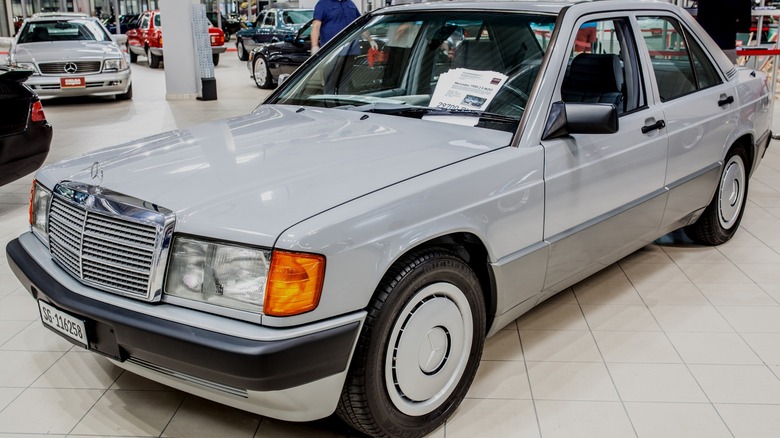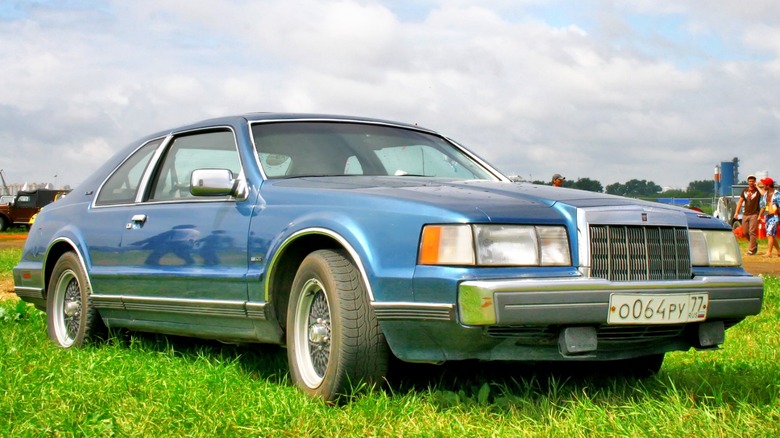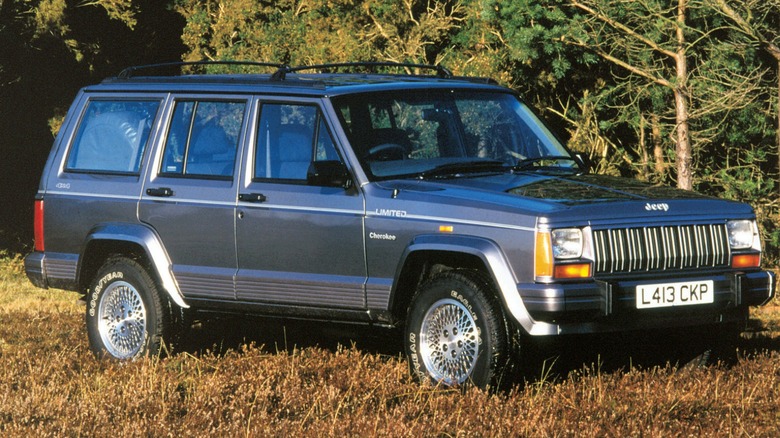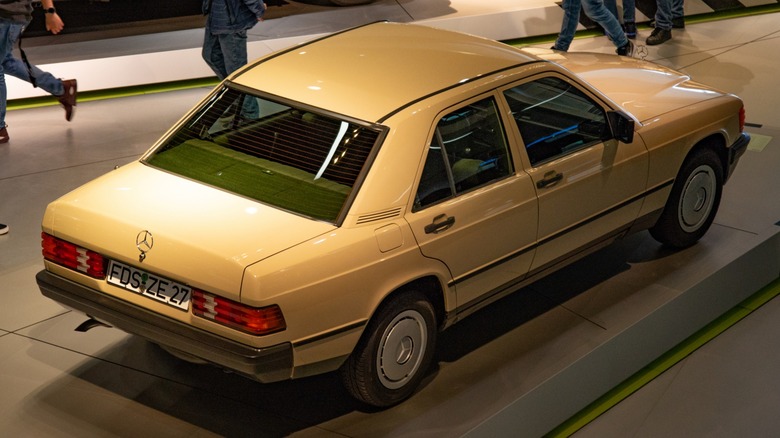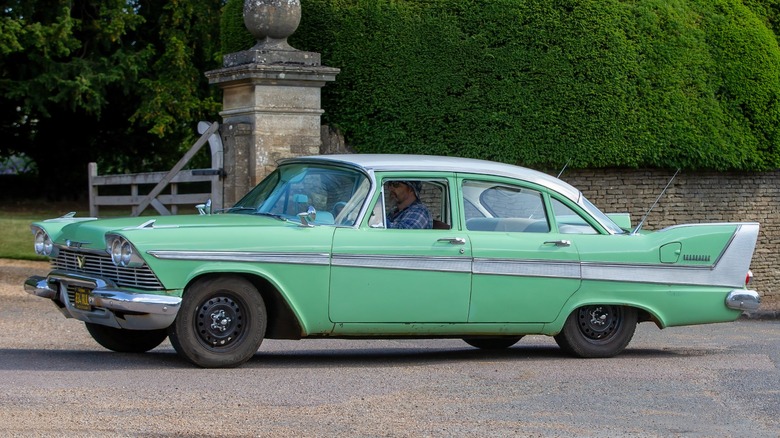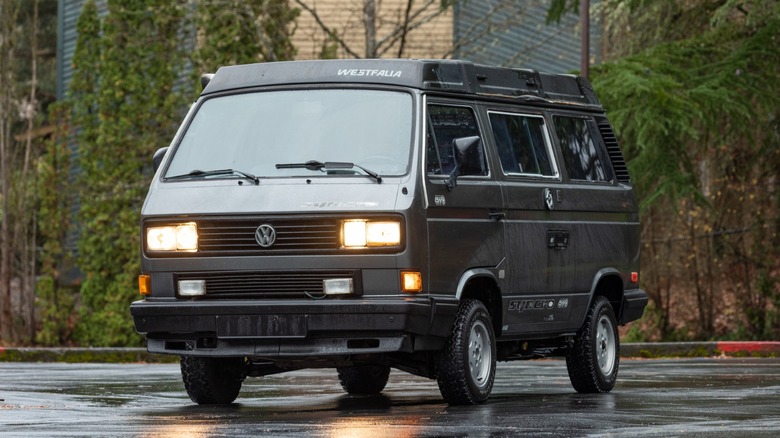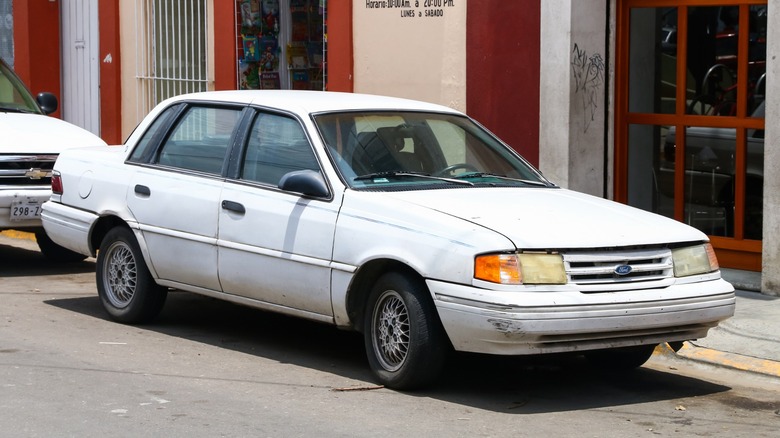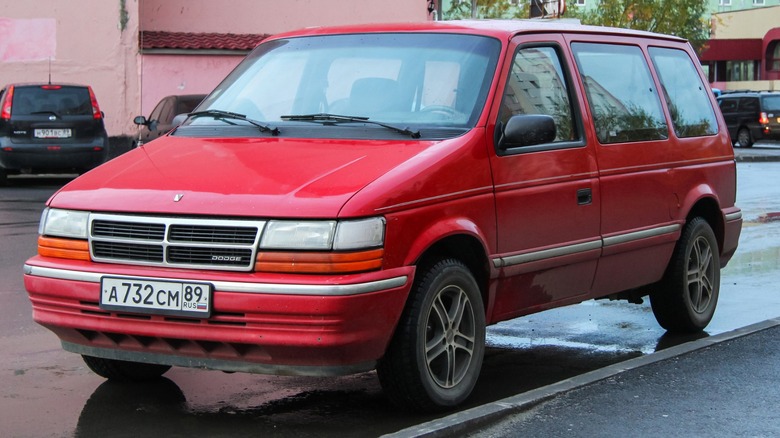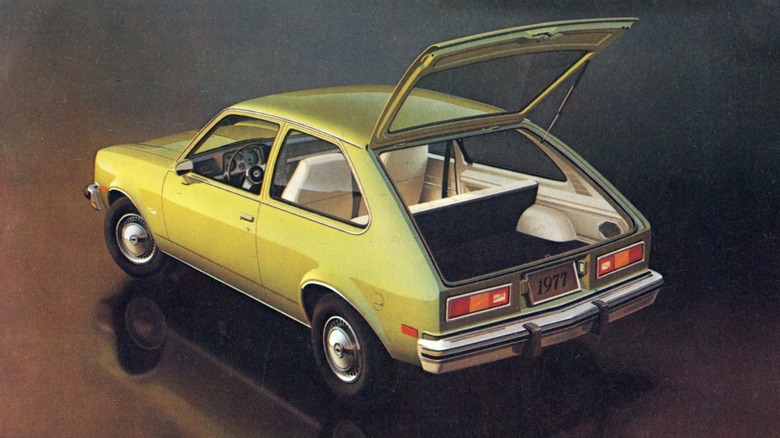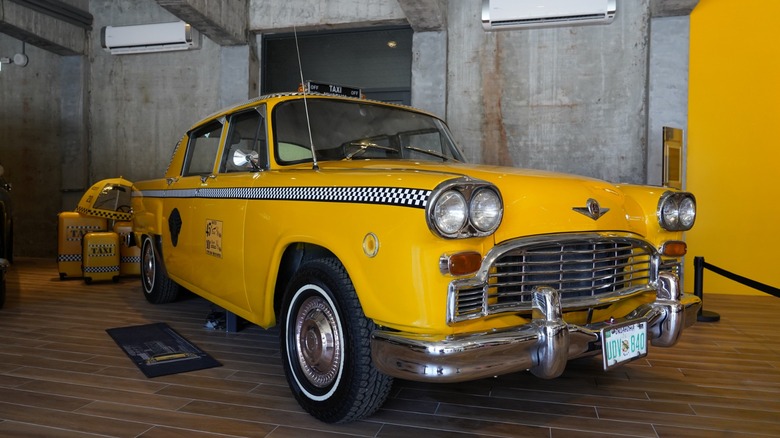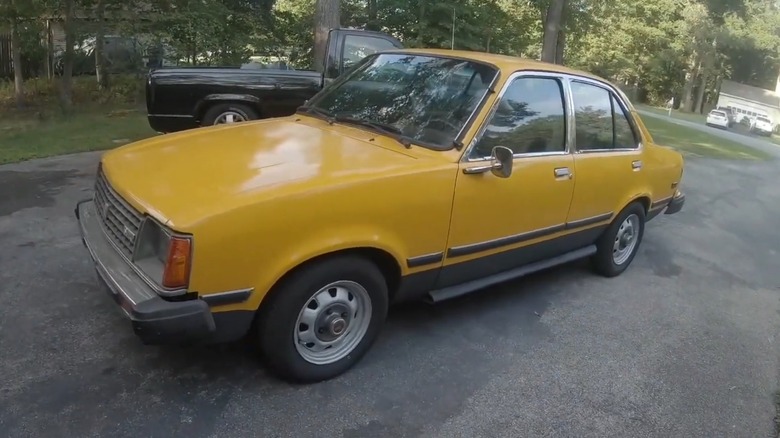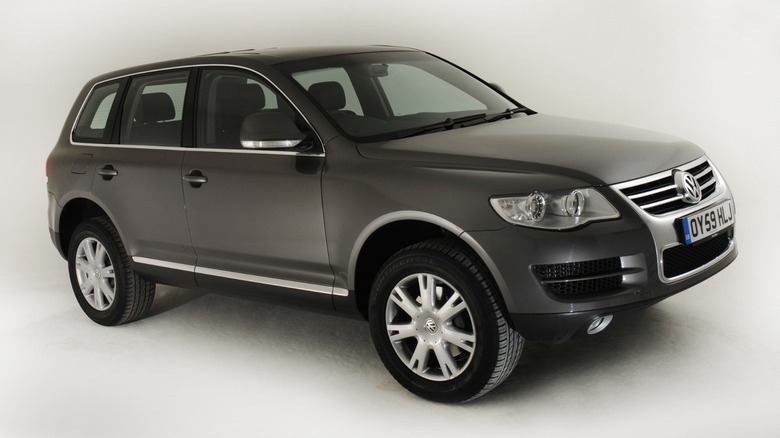11 Classic Diesel Cars You Might Not Have Known Existed
Diesel engine cars have never been a large part of the automotive landscape in the United States, although they have long been favored by a large contingency of European drivers. Diesel power has been available in passenger cars for many decades. Yet, diesel power in American cars never gained a foothold in the market largely due to the owner experiences with the Oldsmobile 5.7-liter diesel V8 developed in the late '70s. Because of GM's negligence during development of its diesel V8 and fallout from its failure, diesel engines have remained unpopular choices in the U.S. ever since.
Despite this unpopularity, a handful of models have made it into dealerships. Some eventually found success, such as models from Volkswagen, which enjoyed good sales until the Dieselgate scandal renewed American aversion to diesel power. However, VW diesels are not the only models to infiltrate the market, although few of them ever received much recognition or publicity. Diesel passenger cars have remained available in the U.S. over the years, including many you probably never knew about.
Lincoln Continental Mark VII
For a period after WWII until the modern era, Lincoln cars were known for being large and luxurious with power coming exclusively from robust Ford gasoline V8 engines. The 1988 Lincoln Continental broke the mold when it arrived with a transversely-mounted 3.8-liter V6 driving the front wheels. However, there was a Continental a few years earlier that was not often covered and eschewed the thirsty gasoline V8 engine for a more miserly diesel.
While GM chose to jump on the diesel bandwagon with a new engine of its own design, Ford sought to crack its way into the market while relying on someone else's expertise. This resulted in buyers having the option in the 1984 to 1985 Lincoln Continental Mark VII luxury coupe with either a Ford V8 or a straight-6 turbo diesel engine from a European competitor.
Instead of shelling out an exorbitant sum to engineer and develop a new diesel engine program in the way GM did, Ford executives called Germany and asked BMW to supply some engines for its downsized Continental. This resulted in installation of 2.4-liter BMW diesels with ZF 4-speed transmissions. This block was good for just 115 horsepower and some degree of torque, although its actual rating didn't matter — the short-lived option lasted through 1985 and sales were slower than the car itself. Only about 1,500 of these cars were made in all, making them rare finds today.
Jeep Cherokee
Recent models of Jeep vehicles have been available with a 3.0-liter EcoDiesel engine, but they are not the only diesels ever offered by Jeep. During its ownership by Daimler, Jeep offered a version of the liberty with a robust Mercedes common rail diesel V6, and early models of the CJ-5 could be ordered with a Perkins diesel. What is much lesser known is that a version of the first generation of Jeep Cherokee was built with a diesel option, but mostly in Europe.
Jeep was under the ownership of AMC for a long time, and when a large part of the company was bought by Renault in the '80s, its substantial influence reverberated throughout the halls of AMC/Jeep. Not only did Renault donate its fuel injection technology, known as Renix, as the first fuel injection system for Jeep, its well-established development of diesel engines led to the offering of Cherokees with a 2.1-liter Turbodiesel.
The diesel option was available in Europe and the United states beginning in 1985. These engines delivered up to 29 mpg with a 5-speed manual or 23 mpg with a 3-speed automatic transmission. The diesel option was offered as a means of offering good economy more than power and torque. These small diesels were not the high-torque engines available today and sold in extremely small numbers, making them practically impossible to find used today.
Mercedes-Benz W201
Mercedes-Benz first entered the compact car segment when it introduced its W201 chassis in 1982. Truthfully, this was a mid-size sedan but it was considered compact for the company, and it proved to be a competitive model and popular for those looking for luxury in a smaller package. By far the most popular version of the W201 was the 190E, which featured a 2.0-liter 8-valve 4-cylinder engine, although more performance-oriented versions became available, including 2.3-16, the British-engineering-firm-tuned Cosworth 190E, and the incredible 2.5-16 Evo II.
Much less exciting and popular than the speedy petrol-powered Mercs was the dowdy 190D. Initially, the engine offered in the 190D was a 2.2-liter naturally aspirated diesel later replaced with a turbocharged 2.5-liter model in 1987. While it was advertised as the "whisper diesel" due to its quiet operation and added soundproofing, performance was never going to be a factor for buyers of this highly efficient engine option. With just 72 horsepower, not only was it not going to win any races, it might even not make it on the highway, especially 40 or so years after it left the factory.
Plymouth Belvedere
When speaking of Chrysler products, there was a short-lived Dodge diesel in 1942 followed by the use of Perkins and Mitsubishi engines, and finally the legendary Cummins diesel engines that have been used in Ram trucks from 1989 until today. However, diesel cars have never been a well-known or publicized feature of any Chrysler passenger car, yet there was a time that they were available.
Since the 1930s, Perkins has been manufacturing diesel engines in the United Kingdom that have been found in a wide variety of applications on land and water, including many cars. While the information is scarce, records show that Chrysler International, the European arm of the company in the middle of the 20th Century, offered a select range of cars with Perkins 4-cylinder diesel engines.
Europeans taxi drivers in the '50s liked to use American cars for the ample space afforded to passengers and their luggage but did not care for the poor fuel economy of gas-hungry American engines. Fuel has always been costly in Europe, and it made sense to offer slow but durable and efficient Perkins diesel engines in these cars. Some of these even made their way as new models to Canada. Many of them were factory installed in Antwerp, Belgium while others were converted after the fact. Among the models to receive a Perkins engine were the Belvedere, Savoy, and Valiant.
Volkswagen Vanagon
The Type 2 "Bus" or "Microbus" attained legendary status as the endearing hippy wagon back in the '60s, and split-window VW Buses have turned into a modern day investment safer than the S&P 500. But as Beetle production for the U.S. wound down at the end of the '70s, so did production of all of VW's air-cooled products. The Type 2 was replaced by the Transporter, which is known in the States as the Vanagon. It has also become a legend in itself, particularly the Westfalia camper conversion models.
The new bus came powered by a new water-cooled 4-cylinder boxer engine known as the Wasserboxer. Additionally, buyers could opt for a 1.6-liter inline 4-cylinder engine much like those found in diesel Rabbits of the era. Although, being so much larger than a Rabbit, the Vanagon would have been even slower that the already nearly-slower-than-walking Rabbit with the same engine. In the Vanagon, horsepower was rated at just 48. Power steering and air conditioning were not available, and that's probably for the better.
The diesel variant in the U.S. was only offered for two years, 1983 and 1984. It may have been offered elsewhere but not would still not be likely to have much more in the way of performance.
Ford Tempo
Among the influx of small American cars of the '80s are a few models that rarely received mentions on the pages of glossy car magazines. This is because they are largely forgettable econoboxes. A perfect example of this is Ford's Tempo, built from 1984 to 1994 along with its Mercury twin, the Topaz.
Upon introduction, the Tempo did set the stage for later Ford car design by introducing the public to a more streamlined and curvy look that moved away from the stodgy, boxy, and chrome-adorned look so prevalent among American cars. The Tempo felt more European and modern, following common styling trends of the day. However, looking upon it today, modern eyes see a lump of slightly molded metal powered by equally uninspiring engines. Furthermore, a few brave souls opted for a lesser-known engine option, the diesel.
Thanks to Ford's corporate ties with Mazda, the engine powering the Tempo was a well-built and reliable option. Mazda diesel trucks have long been known for reliability, and a steady supply of engines were available to Ford. Offered from 1984 to 1986, the diesel Mazda engine only produced 53 horsepower. While it went into a car that was relatively light, it would still have been way too slow, especially with an automatic transmission common in American cars even then. You would probably have a hard time finding one of these today, but then again, would you really want to?
Dodge Caravan
Since its debut in 1984, Dodge Caravans have been ferrying kids to school, practice, orchestra recitals, and every other type of extra-curricular activity imaginable. Under the tutelage of automotive legend Lee Iacocca, Dodge introduced the world to its Caravan, ushering in the era of the minivan. This model was highly consequential as it was the first van to be built on a front-wheel-drive unibody chassis shared with cars — and it was a rousing success.
Being built on a car's chassis meant it could be driven by a range of simple and efficient 4-cylinder engines. With the lack of a driveshaft, the floor could be placed much lower, giving the van more car-like driving characteristics, an appealing feature for most parents. Initially, engines were a fuel-injected 2.2-liter 4-cylinder, joined by a Mitsubishi 2.6-liter V6 a couple of years later. A 2.5 turbo option was later added but was quickly discontinued.
Chrysler minivan sales commenced in Europe in 1992 targeting the popular Renault Espace as competition. Engine options were again a 4-cylinder with the larger V6 option joined by a diesel. Unlike any American version, European minivans could be had with a 2.5-liter turbodiesel 4-cylinder courtesy of VM Motori, a large diesel engine manufacturer based in the Old World. The other fascinating option is a 5-speed manual transmission, something inconceivable to find in an American minivan. While they may be common overseas, one found Stateside would be a true unicorn.
Chevrolet Chevette
The 1970s posed a range of challenges to automakers. They had to quickly react to both market conditions and regulations in bringing new models to market that could satisfy all stakeholders while turning a profit. Some attempts were more successful than others. One model that was not was the Chevrolet Chevette, GM's answer to fuel-efficient European and Japanese hatchbacks.
As it was designed and built from the start to be as cheap as possible, the Chevrolet Chevette was doomed from the start. With a legacy of building large and powerful cars, Chevrolet had to essentially start from scratch doing something it did not know how to do. Unlike the foreign competition, who began building tiny cars after WWII, Chevrolet in many ways was "winging it."
The result of its efforts was a compact hatchback that actually offered reasonable space inside but was powered by engine choices that barely allowed drivers to move out of their own way. The base 1.6-liter engine was good for a ¼-mile run of nearly 20 seconds, barely exceeding 60 mph. Power output was just 60 horsepower. However, it got worse. The optional 1.8-liter Isuzu diesel only made 51 horsepower, and it might give out before ever reaching 60. While achieving more than 40 mpg is nice, few people wanted to sacrifice any semblance of acceleration for economy.
Checker Marathon
The quintessential yellow taxicab of American streets is a quickly fading icon struggling to remain relevant in the era of ride sharing apps such as Uber and Lyft. Yet, there was a day that yellow cabs were so common on American roads that an auto manufacturer existed building nothing but purpose-built taxicabs, Checker.
Checker Motors Corporation of Kalamazoo, Michigan built cabs from 1923 to 1982. After the war, new designs with contemporary styling began filling the streets of American cities, with the final Checker A9, aka Marathon, model being produced with few styling updates from 1960 to 1982. These cars offered ample seating with generous legroom for passengers and an enormous trunk for all the luggage. Some models even had a couple of fold-down jump seats installed for additional passengers.
While Checker was an independent automaker, it leaned on GM heavily for parts, using them for various pieces around the car and powering them with Chevrolet straight-6 and V8 engines. However, for one year only, Checker offered its oversized sedan with diesel power. Like other automakers at the time, Checker offered the durable and thrifty Perkins 4-cylinder diesel engine in 1968. Checker had aspirations for this engine to be a regular thing, but sales must have been disappointing as it was immediately dropped. Finding a diesel Checker today is likely an impossible task, although Barn Finds managed to find one in immaculate condition listed on eBay in 2016 with a Buy It Now price of $12,000.
Isuzu I-Mark
Some today are only familiar with the Japanese manufacturer Isuzu because of its range of heavy-duty delivery trucks. Others may recall the passenger vehicles of the late '90s and early 2000s such as the Trooper, Rodeo, Amigo, and the undefinable and bizarrely styled Isuzu Vehicross. But before it made a name for itself building diesel trucks, Isuzu built cars, and some of them were sporty and remain underrated classics today.
Isuzu's first passenger car came in 1961 with its Bellel and new car development continued for some time. Among later models was the I-Mark, which lasted through the '80s, and its high point was the I-Mark RS Twin-Cam in 1989. Its handling was tuned by Lotus and the 16-valve 4-cylinder engine was good for 125 horsepower, which provided a highly competitive power-to-weight ratio compared to other cars in its class. Furthermore, its exterior styling gained a spoiler, ground effects, and bold paint colors.
As good as the RS was, its performance was the polar opposite of I-Marks with the diesel engine option. The diesel was available early on in its life cycle, and Motorweek spent time to review one in 1982. It had previously been sold as an Opel by Buick dealers but came with Isuzu badging in 1982, also the first year for the diesel option. With 50 mpg fuel efficiency, it made for an affordable driver, and it was noted for decent acceleration at lower speeds but a sharp drop off once it gets going.
Honorable Mention: Volkswagen Touareg
This is a relatively new model but its diesel engine is so bonkers it merits a mention. Volkswagen's TDI engines originating in the '90s helped establish VW as a premier diesel engine maker until Dieselgate exposed the company's emissions testing cheating.
In 2004, VW released a version of its largest SUV, the Touareg, with its largest diesel ever. Capitalizing on its turbo direct injection (TDI) technology, it expanded a diesel block to a near-ludicrous 10 cylinders displacing a total of 5.0 liters. While the old GM diesel displaced 5.7-liters, it was a dog with barely more than 100 horsepower. In contrast, the V10 TDI output of 310 horsepower with 553 ft-lbs of torque was anything but. This power is suitable for pulling tree stumps or hauling skid steers and overkill for rushing kids to soccer practice.
The weight of the diesel engine added to the curb weight of the car. Towing a boat would be a breeze but the capacity of the chassis is likely far less than possible with that much power — a 2008 Ford F250 output is not that much higher. Furthermore, with its circa 2008 retail price touching $80,000, it was as expensive as it was impractical. Granted, the Touareg is an extremely nice vehicle that comes well-equipped and on par with other luxury SUV models. Regardless, it was not a big seller and was limited only to 2004 and 2006 models in the U.S.
